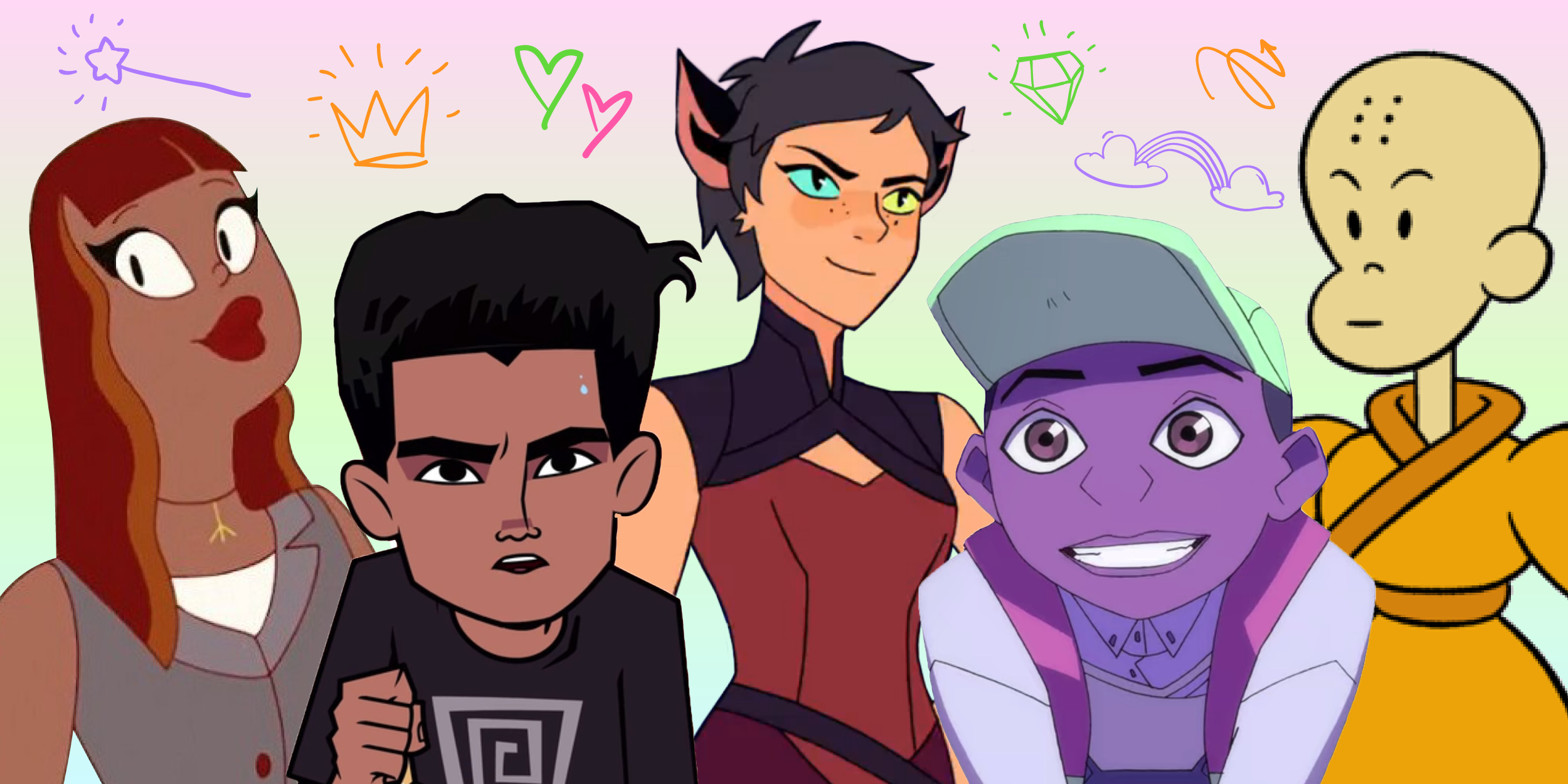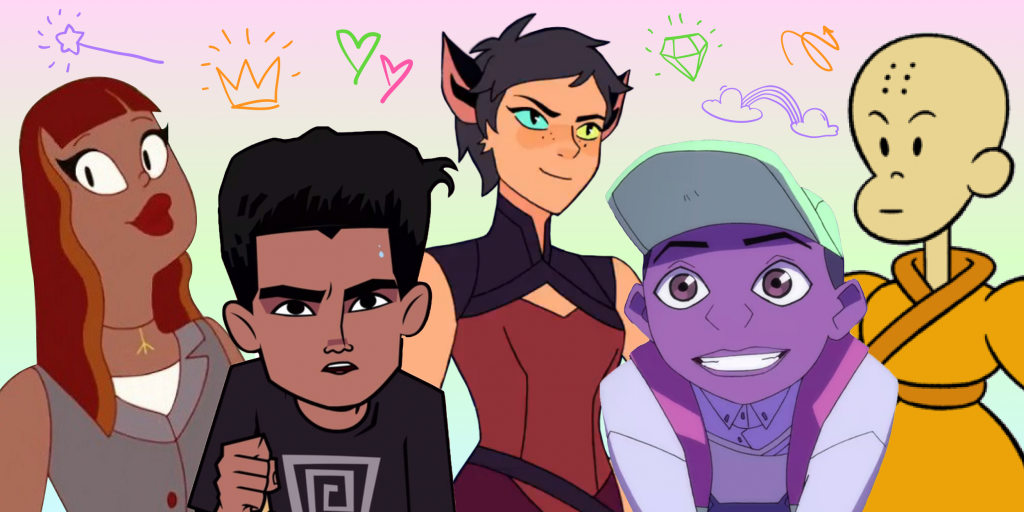
Skye Gould/Insider
- Creators of color in animation are making strides to be truly inclusive.
- Still, Insider found LGBTQ characters of color are receiving disparate treatment in animation.
- It mirrors how creatives of color are being treated in the animation industry.
- Visit Insider's homepage for more stories.
When creator Rad Sechrist and showrunner Bill Wolkoff pitched "Kipo and the Age of Wonderbeasts," both knew they wanted their story, that follows a girl in search for her father in a post-apocalyptic Los Angeles, to feature a relatable gay character.
Sechrist told Insider that the two saw "there weren't these iconic Superman or Spider-Man archetypes very often as a gay person in media. A lot of times … you would be like villains or like someone who's comic relief."
What they didn't know was that their pitch for Benson, the DreamWork's series' dorky but endearing cool kid who befriends 13-year-old lead, Kipo Oak, would make history. In January 2020, during the show's debut season, Benson became the first Black lead character, and only the second-known animated kids character (behind Canadian series "6teen"), to identify themselves as gay in dialogue.
Glass ceiling moments historically go to white characters, with Insider's database confirming the appearance of white LGBTQ characters as much as a decade earlier than LGBTQ characters of color in kids' animation.
"White people were allowed to be gay, in a sense, or be queer as an identifier," said Parvesh Cheena, a gay Punjabi actor and voice talent for several popular animated kids series. "People see our color and ethnicity first before our sexuality."
Although the industry is making strides to be truly inclusive, animation creatives of color who spoke to Insider said because those with lived experience are not in influential positions behind-the-scenes, onscreen many brown and Black LGBTQ characters continue to be shown in ways that can be harmful to young viewers of color.
Insider's data shows LGBTQ characters of color and industry members are receiving disparate treatment in animation
In its own analysis of 259 LGBTQ cartoon characters, Insider found that the first LGBTQ character of color debuted a full decade after the first white human character. Furthermore, only 10 out of just 70 identified people of color - including Black, American or Alaskan Indigenous, Latinx, Asian, Pacific Islander, and multiracial characters - had leading roles.
A significant proportion of these characters lacked explicit racial specificity in their shows, featured fictional combinations of real-world cultures, and offered a mix of nonhuman racial metaphors, the latter of which many young children don't understand.
For example, in one of her studies, Louise Mares, professor of Communication Science at the University of Wisconsin-Madison, found that kindergarteners who watched an episode of"Clifford the Big Red Dog," featuring a three-legged dogdid not translate the show's conversation around human disability and acceptance.
Instead, "the takeaway message to them was be nice to dogs with three legs," Mares told Insider.
Although ability and race aren't the same, it hints that animation's less-than-direct approach to racial LGBTQ representation can be confusing to kids.
It also points to a larger problem lurking behind the scenes, driven by who is making creative choices about how POC LGBTQ characters are represented.
A historical lack of POC in animation has created a 'white passing narrative,' one writer said
Similar to the lack of explicit identification around animated LGBTQ characters' orientations, many brown and Black LGBTQ characters continue to exist ambiguously onscreen, frequently lacking regional nuances and cultural distinctiveness, or being voiced by actors who aren't of the same race.
"White passing narrative is what I call it," Taneka Stotts, a Black genderfluid writer who's worked on "Craig of the Creek" and "Steven Universe Future," told Insider. "It's usually where the narrative is written in a way that it's white-passing enough to get past your executives and the powers that be."
Mae Catt, a queer Asian-American writer on "Young Justice" and Marvel's "Spider-Man," told Insider that when shows aren't run or written by people of color, characters exist "purely as surface decoration" and "race representation goes very similarly to queer representation where it's just enough to have them there."
"When you have these characters that don't have their cultural identity, there is an unspoken implicit destructive bias that occurs - that this behavior is the correct behavior and this behavior is inevitably white," Catt said. "It isn't teaching you to embrace a part of yourself. It's teaching you that that part of yourself doesn't deserve to be on television, or doesn't exist beyond your home."
Research conducted by Brad Bond, an associate professor researching media psychology at the University of San Diego, echoed Catt's sentiments around media representation.
"If somebody like you is not on screen," Bond said, "then ultimately what message that sends is that you're unimportant."
Creatives and advocacy groups say the industry is shifting its hiring practices but is still falling short
Animation industry creatives who spoke to Insider said they are seeing more efforts to hire creatives of color, but that there are still gaps with creatively influential positions like writers and showrunners.
"There was a show that happened to have a Latina character, and a couple of other diverse characters, but the writer's room was entirely white," Latinx in Animation co-founder Bryan Dimas, who didn't identify the show by name, told Insider.
"Throughout the life of the series - around 52-ish episodes - I don't think they ever had a person of color that was a writer on that show other than one of the executive producers and some of the production crew."
Dimas said that shows are gradually moving away from "having white writers writing for Black characters or Asian characters or Latino characters," a dynamic that has long been present in animated kids series.
Amid this shift, TV series are also leaning more into hiring people of color to work as creative consultants, an industry practice that dates back to the 70s for Black creatives, according to Christopher P. Lehman, author of "The Colored Cartoon: Black Presentation in American Animated Short Films."
Still, that too can come with its own baggage.
Being asked to provide culturally-specific feedback on characters, dialogue, and other elements of the show for white creatives is tricky when communities aren't monoliths, several writers of color told Insider. (Insider is keeping their names anonymous out of fear of industry retaliation.)
One creator, who also didn't want to be named, described it as feeling like a janitor on a series.
Animated series that buck existing hiring practices and prioritize crew contributions are reshaping representation
While kids animation is going through growing pains around its LGBTQ and racial representation, there are creatives on shows and in the industry who are ahead of the curve in changing the industry's long history of exclusion and erasure.
Heralded since its debut for its racial diversity on and offscreen, "Craig of the Creek" is one of the top 10 most LGBTQ inclusive shows in Insider's database. The Cartoon Network series stars three kids, including Craig, its Black male lead, as they explore and go on adventures around a local "creek."
The writing team is led by Jeff Trammell, who told Insider that the show features a "room of 40-plus people on it, all with different backgrounds and different experiences, who are willing to share those experiences."
Trammell, who's been the only person of color in rooms before and knows how heavy that feeling can be, said it was important that his show was different.
"Because our room is open, it never feels like you're the one representative," he added.
When it came to staffing "O.K. K.O.: Let's Be Heroes!" Ian Jones-Quartey avoided an industry habit of relying on "a network of people" who are trusted and often brought in. Instead of hiring creatives from his last project onto his new show, Jones said his team prioritized finding diverse talent with whom they weren't familiar.
"We tried to do as many open calls for tests as we could. The studio had a database and we just sort of cold emailed people," he said. "We would look up their stuff and be like, 'Oh, that seems good, let's ask this person if they want to come in.'"
Others in the industry are being more direct in forwarding directories of writers in animation to studio recruiters, such as Dimas. As a result of those efforts, Dimas believes there's a next wave that's a lot more diverse," including more representation of Latino culture and "not just a certain audience of it like Mexican and Mexican American or Day of the Dead-focused."
In the meantime, Stotts said that creatives like themselves in leadership positions and with hiring power, are trying to do what the industry historically has failed to accomplish.
"What I can do is make sure that when I hire people or when I'm looking at characters that are being created, I'm creating them for a very specific reason, which is that it's not a bingo card. It's literally what I've lived," Stotts said.
